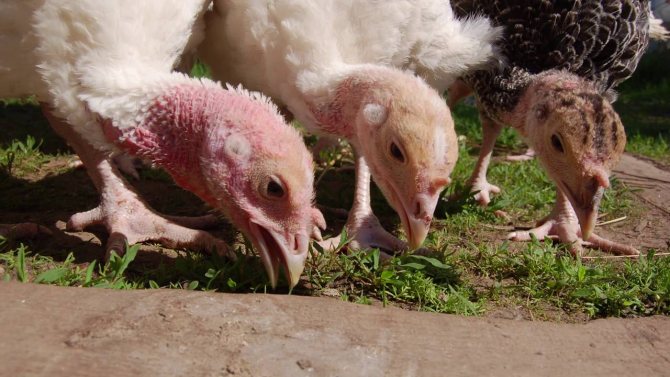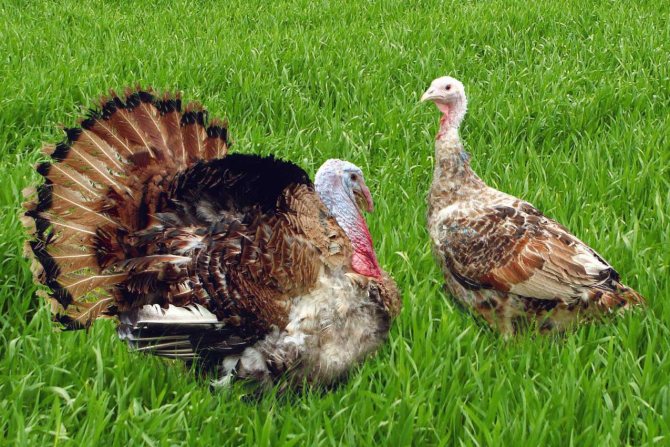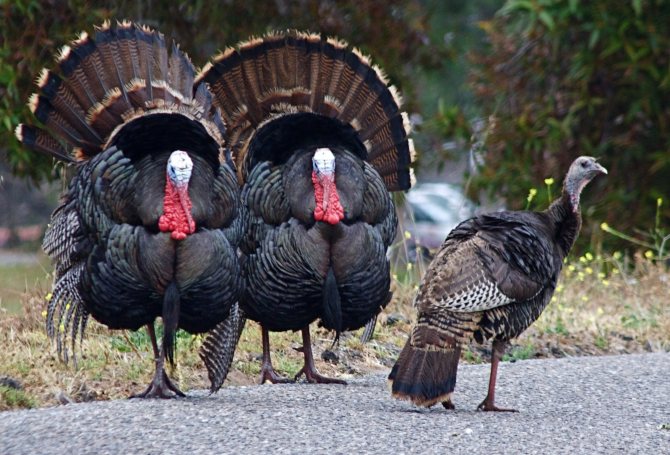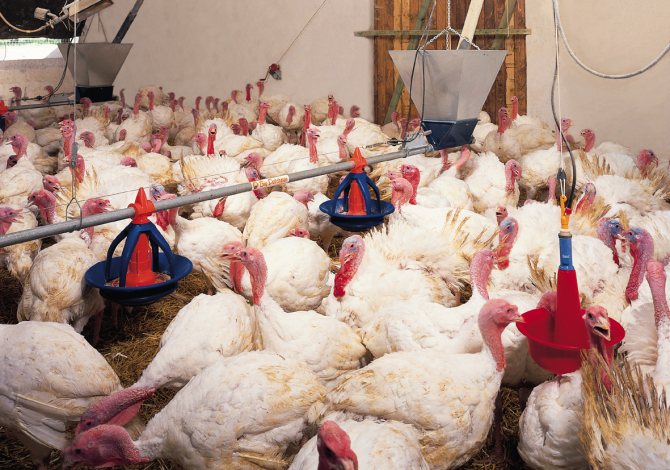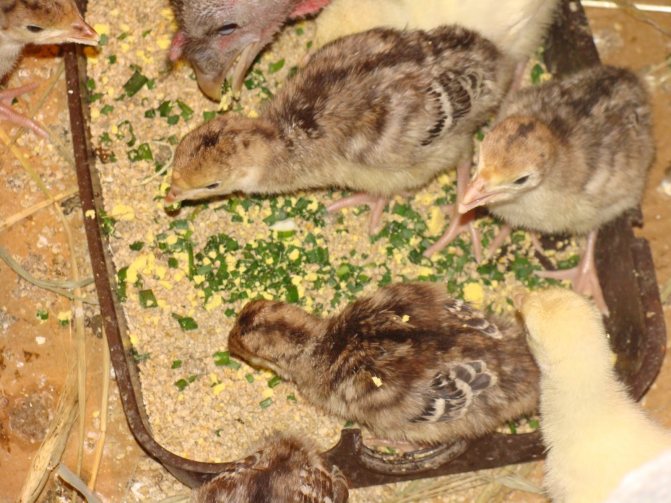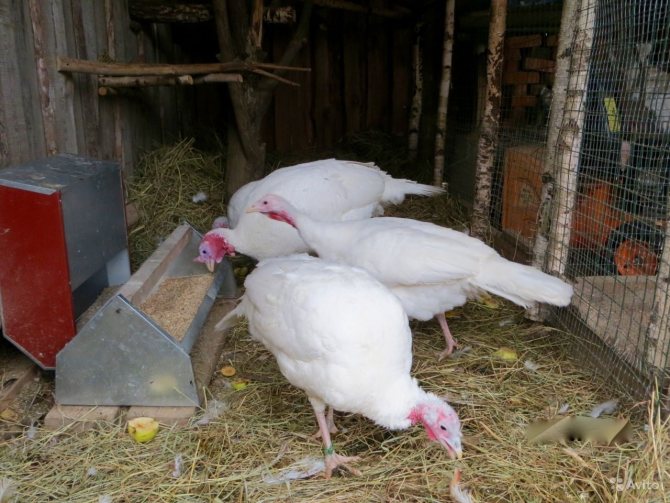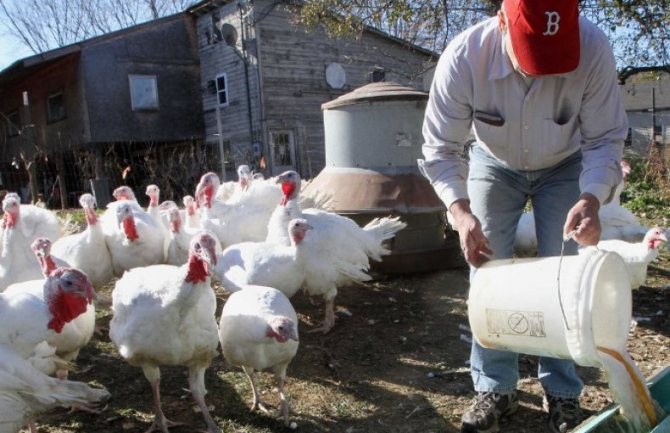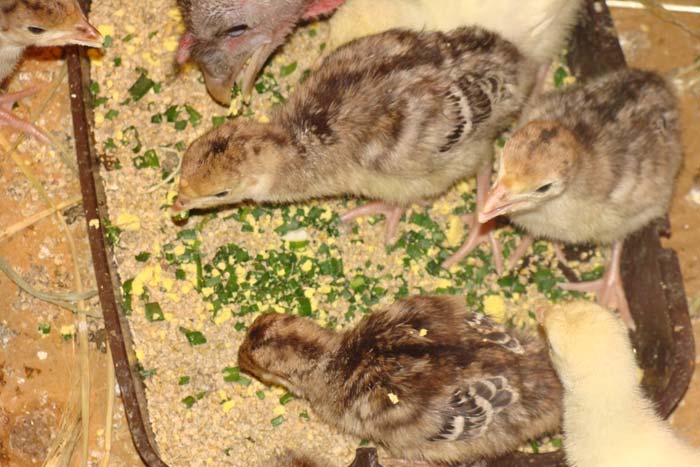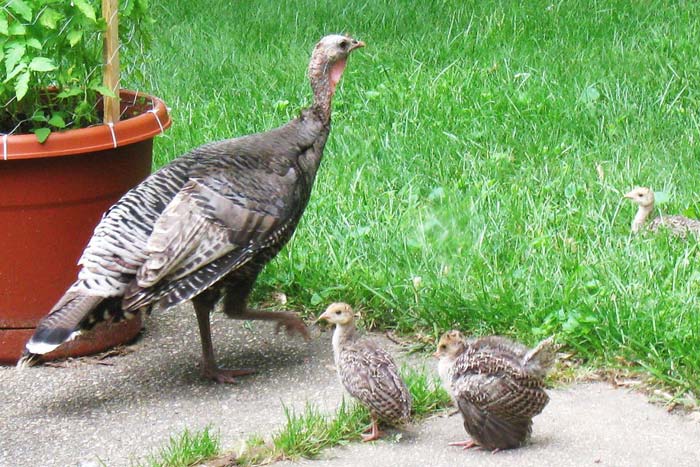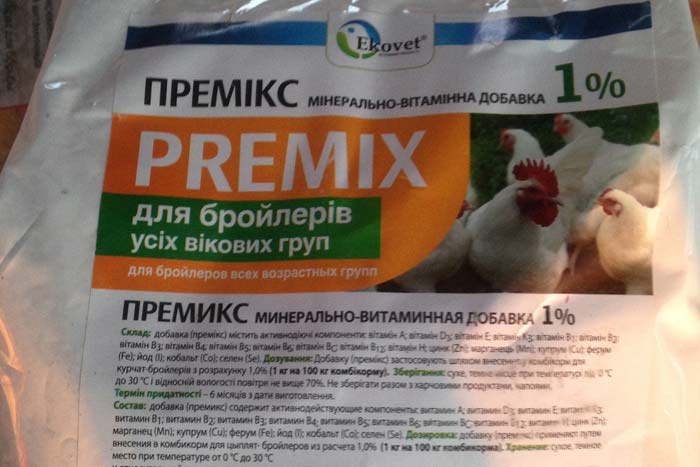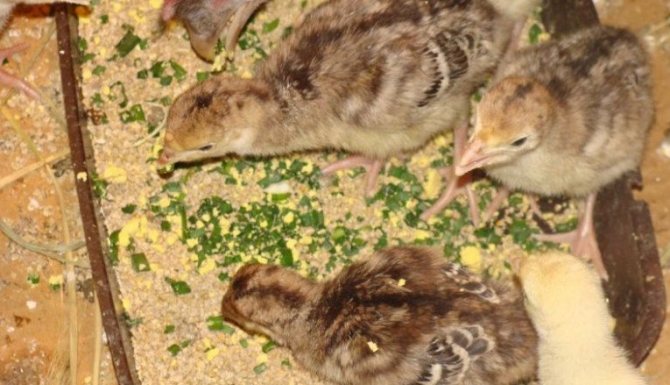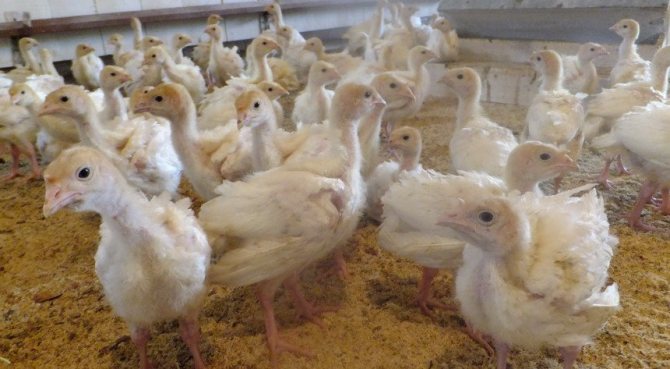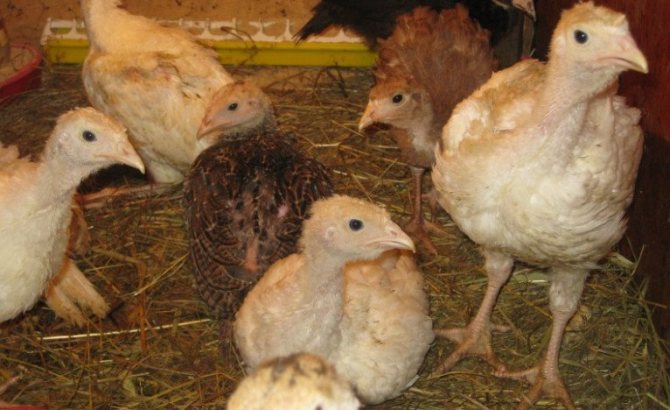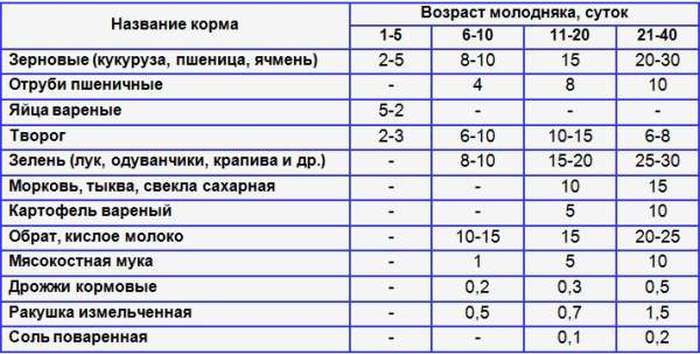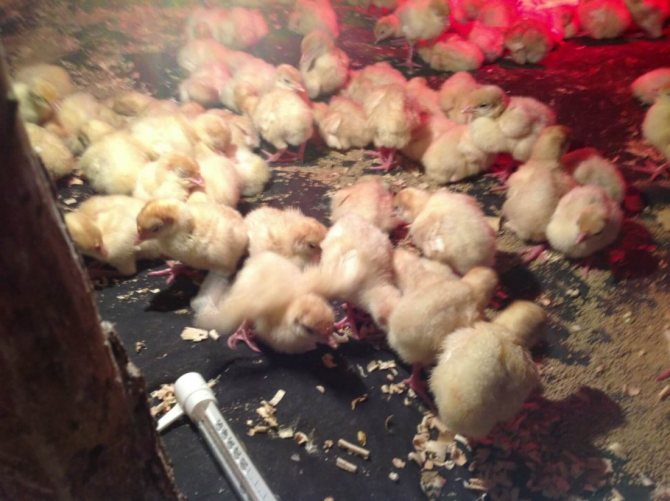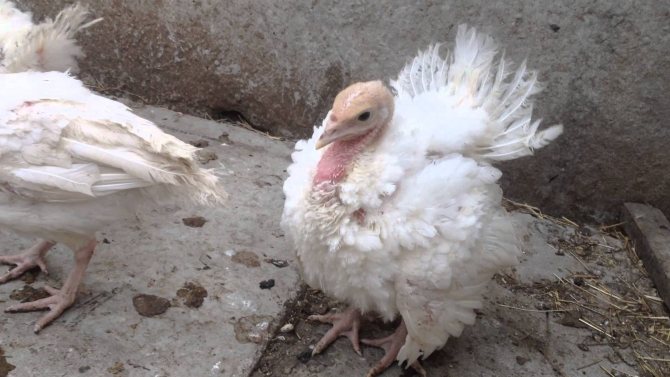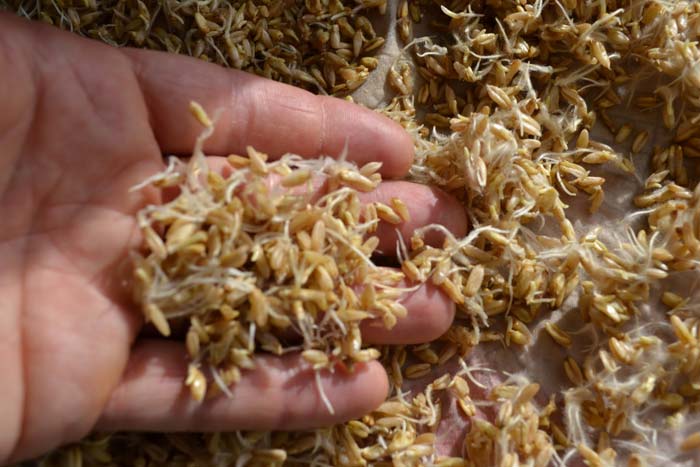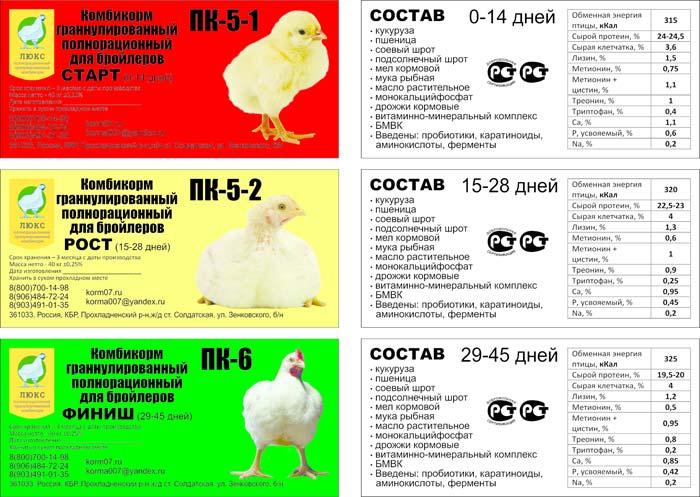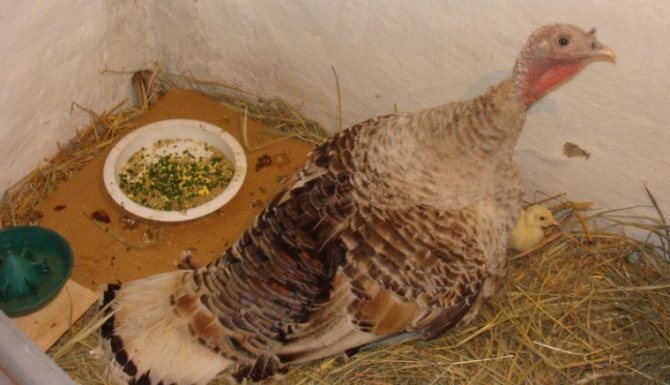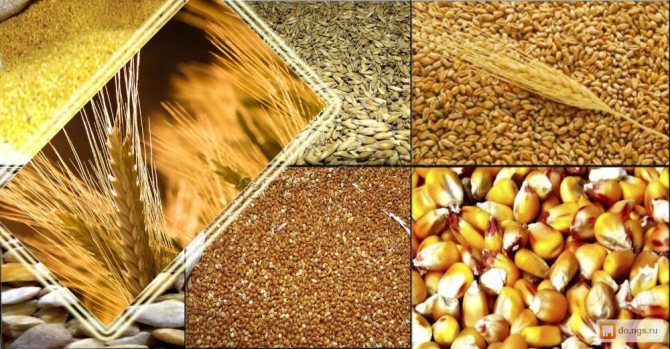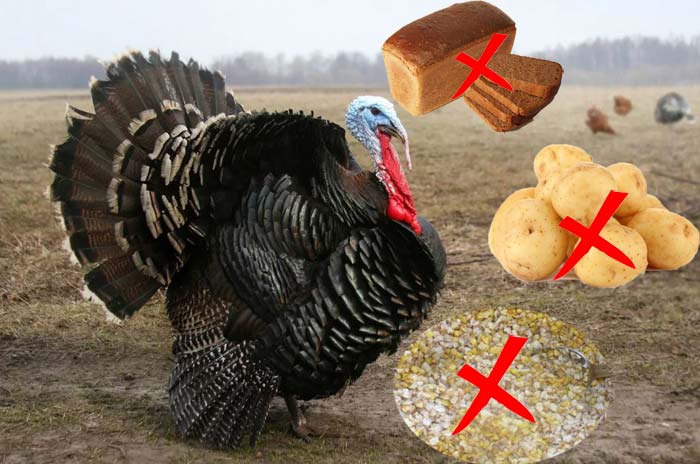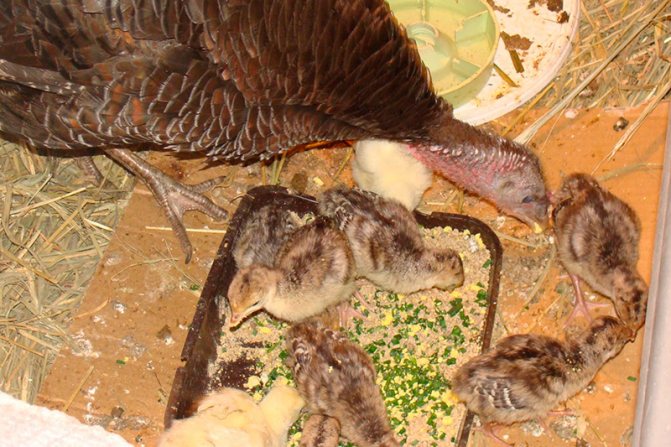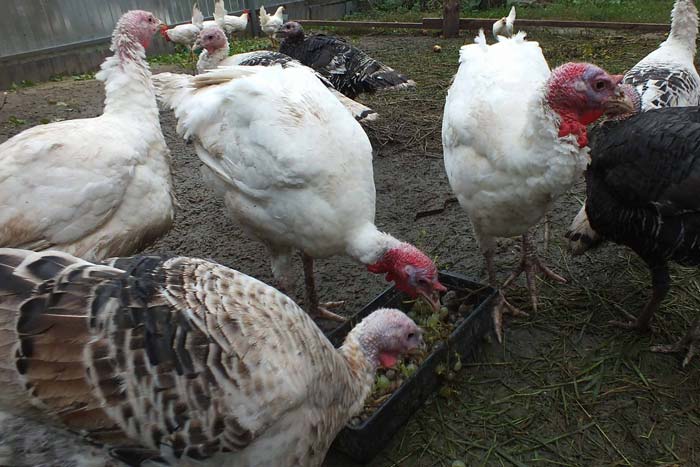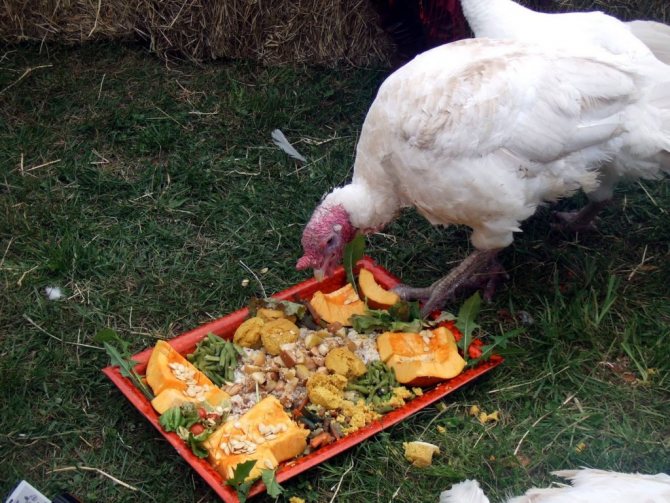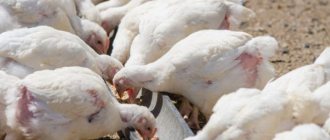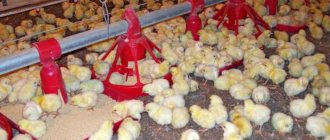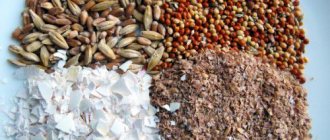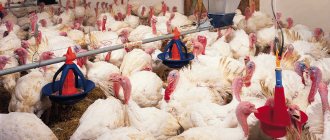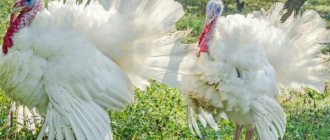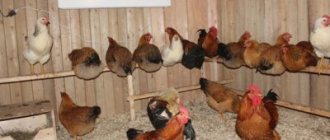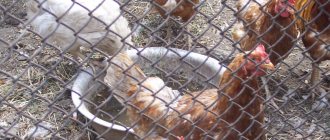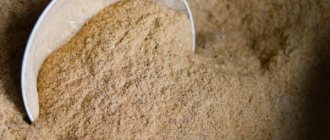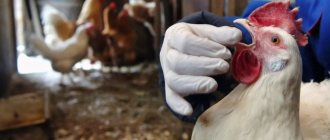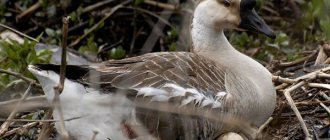»Poultry» Turkeys »Feeding turkeys at home - how to make a diet
0
9
Article rating
Increasingly, turkeys are bred in private farmsteads. They gain weight quickly and do not cause much trouble to maintain. However, feeding has its own challenges, especially in the first months of life.
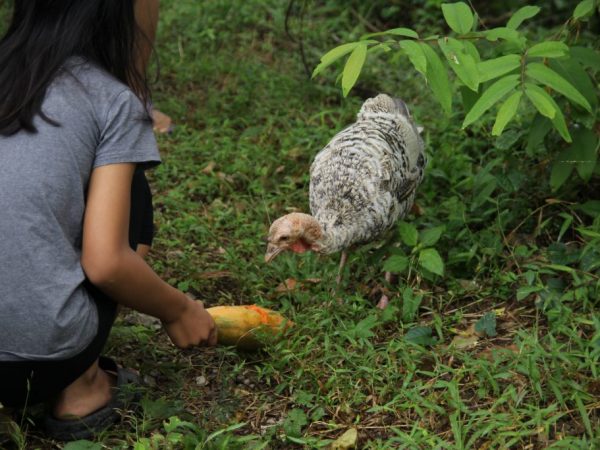
Feeding turkeys at home - how to make a diet
Rules for feeding turkeys at home
It is very important to keep an eye on where the birds are feeding. This is especially true for young animals. Food tends to deteriorate quickly due to the abundant amount of greens, dairy products and wet mash. Keep feeders clean and dry. Do not leave raw food that has not been eaten by the bird. It deteriorates quickly and can harm the gastrointestinal tract and overall health of the bird.
The main criteria for feed for turkeys, as for other birds, are calorie content and nutrient saturation. Throughout the entire rearing of a bird, it is important to provide feed that contains all the necessary elements, including fiber, as well as macro and microelements.
Adults should be fed three times a day and given constant access to clean water. The diet is based on legumes and grains. Often the feed consists of wheat, barley, buckwheat and oats. Hay and straw are also good for poultry - they provide a large amount of fiber, which aids digestion.
Along with feeding, it is important to know about the correct maintenance of turkeys. Therefore, we suggest reading this article.
Which herb is beneficial
Let's continue talking about how to properly feed this proud bird. Novice turkey herd owners are interested in whether grass is needed in the poultry diet. Grass and greens must be given to turkeys. It is offered for three-day-old turkeys. The greens are finely chopped and introduced into the mash. Children especially like green onions - the best delicacy.
Important! Onions are added to the mash during morning feeding.
What else can you feed from garden greens:
- Arrows of onions, garlic.
- Cabbage leaves, dill.
- Lettuce leaves, parsley.
When the turkey poults are one month old, they hang the grass in bunches. Two-month-old pets can graze on their own. Almost all the useful grass that can be given to these birds grows in the garden.
The picture shows useful plants.
Turkeys gladly eat wild-growing grass, great connoisseurs of dandelion, clover, quinoa, woodlice. Wormwood is needed to stimulate the digestive process.
If there are reservoirs nearby, then duckweed can be added to the mash, pond is a storehouse of microelements.
A warning! The picture below shows wild herbs that are prohibited from feeding to the entire turkey tribe.
Homemade food
A complete combined feed must include:
- corn;
- wheat;
- barley;
- peas;
- meal;
- feed yeast;
- return;
- fish meal, meat and bone meal and herbal meal;
- tricalcium phosphate feed and impurities.
You can mix feed in different proportions, but you should take into account the daily intake of certain products.This will make the diet balanced and avoid the lack of certain nutrients, vitamins and elements.
How to prepare food yourself
It is necessary to take peas, crushed corn grains, wheat with yogurt, whey or skimmed milk in equal proportions, mix the composition and immediately give to the bird. Instead of dairy products, when the turkeys reach the age of two months, the mash is prepared on the basis of water. Youngsters need to mix special vitamins, as well as cabbage leaves, green onions, beetroot.
Experienced poultry breeders recommend these foods:
- A mixture of barley and oats.
- Flour mixture.
- Special compound feed.
- Boiled potatoes.
- Milk products.
- Yeast.
- Finely chopped greens of clover, duckweed, gentian, lettuce, nettle.
- Cake.
When breeding turkeys, it is not necessary to buy factory feed. You can prepare your own food at home. To do this, for 300 g of crushed cereals (barley, oats, you can use corn), you will need 50 g of bran and vegetables. It is recommended to use pumpkin, beets or carrots as vegetables. Boiled potatoes are also added to the mixture (no more than 100 g).
Next, 70 g of grain, 10 g of meat and bone meal and chalk or shell rock, 100 g of chopped fish or meat waste and 2 g of salt are added to the homemade food. All ingredients are mixed together.
Vitamin and mineral supplements
Supplements are an important component in poultry nutrition. These can be both premixes and pure dietary supplements, as well as vitamin and mineral preparations.
Young animals are given such additives in the form of concentrated drugs in powder or liquid-soluble form. They include all groups of vitamins, trace elements and minerals. They prevent the development of diseases, compensate for the lack of substances, and are also an auxiliary therapy for infectious and parasitic diseases.
This type of supplement for adults can reduce feed costs and improve nutrient absorption. But it is worth remembering that vitamin and mineral supplements cannot be combined with compound feed, and premixes cannot be diluted in warm water.
Selection of poultry for feeding
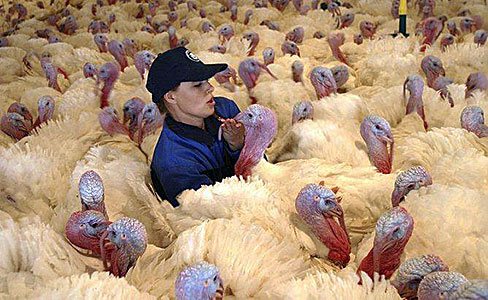

They begin to feed for meat from about 4 months after the end of the molt. Part of the birds can be slaughtered already at this age, if they are sufficiently developed, have finished molting, gained weight corresponding to or exceeding the weight for their age.
When feeling the turkey, developed pectoral muscles should be found, on the pubic bones - a layer of fat.
Selective slaughter throughout the entire feeding period saves feed and simplifies maintenance.
Approximate daily diet
There are several factors to consider before composing a poultry ration. The age and breed of turkeys require different quality and composition of feed. Here is a sample menu for an average type adult:
- Morning: 100 grams of dry mixed feed, 60 grams of grain, 30 grams of bran.
- Day: Moist mash, 450 grams of herbal chopped food, 30 grams of grass flour, 12 grams of millet and peas, 12 grams of chalk, 1.5 grams of salt, as well as gravel and shells.
- Evening: 100 grams of dry mixed feed, 60 grams of grain, 20 grams of bran.
In addition to all of the above, you must also give vitamin and mineral supplements and provide the bird with constant access to clean water.
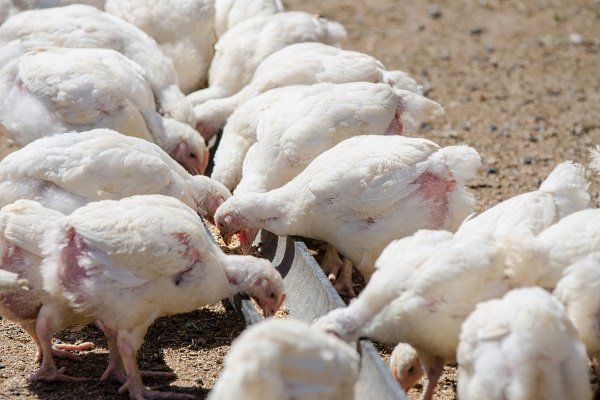

Feeding turkeys from 10 days of age
You need to feed turkeys correctly, first of all, this applies to the daily diet. For example, every day 1 bird should receive 280 grams of various feedstuffs. The table shows the balanced feeding rates for turkeys starting at 1 day of age. It shows how much feed poultry should receive for full development.
Attention! It is necessary to monitor the state of goiter in turkeys at any age, its overflow is fraught with negative consequences.
If in the first days turkey poults are fed every two hours, then starting from 10 days of age, the frequency of food intake is gradually reduced. At the same time, the diet for young animals is significantly replenished. In addition to wet mixtures, in separate feeders, the chicks are offered dry food, half of which consists of grain skins, and an equal amount of sunflower meal and crushed peas. A small amount of chalk is added to the mixture as a mineral additive.
In the menu of 10-day-old birds, boiled potatoes are introduced. At the beginning of such feeding, about 5-7 grams per head should fall, two-month-old turkeys consume 50-60 grams of root crops.
Do not stop feeding turkey poults with protein-rich feeds:
- meat and bone and fish meal or minced meat;
- baker's yeast;
- dairy products.
You can start a gradual transition to feeding not crushed, but whole grains no earlier than 40 days after the chicks are born. At the same time, it is still desirable to give a large grain of corn in a ground form.
Features of feeding chicks
When a chick is born, its weight ranges from 50 to 52 grams. Feeding small turkeys should be done 8 times a day every two to three hours.
Calorie content is the main criterion for the diet of chicks. Foods low in protein cause an increase in the mass of the stomach and gastrointestinal tract. This process will increase the amount of food consumed, but decrease its digestibility. The chicks will eat more, but will lag behind in growth.
Equally important is providing chicks with open round-the-clock access to clean water at room temperature. In addition to food, turkey poults need a lot of liquid for good digestion and functioning.
First 10 days
For the first 48 hours, chicks can live off the remnants of nutrients in the stomach, but do not delay with the start of complementary feeding. It is important to start feeding the poults on time, otherwise the lack of food can affect their growth and development.
On the first day it is recommended to additionally give fermented baked milk, buttermilk and low-fat cottage cheese. Dairy products are very important due to the minimum amount of glycine and arginine in their composition.
The next day, more high-calorie foods are added to the diet. The classic mixture for feeding day-old turkey poults is grated corn with boiled egg. Oat or wheat flour is added to this type of feed in a ratio of 1 to 4.
Daily turkey poults are fed with vitamin concentrate. It is made from a mixture of nettle, alfalfa and carrot juice in equal proportions. On the second day, you can increase the amount of flour in the diet. Usually used barley and wheat.
On the second day, crumbled juicy greens should be introduced and not removed from the diet. Vitamin feed consists of cabbage leaves, alfalfa, nettle, clover and carrot with tops.
On the third day, the chicks are given a well-cooked porridge with additives. It can be grated potatoes or an egg and greens. Chives are especially good as an herbal supplement. Portions should be small so that the turkey's intestines get used to the strain and the new type of food.
The body weight of the chick on the third day of life reaches 70 grams. From this point on, complementary foods should become more varied. It is recommended to include finely ground shells and chalk in the diet.
Wet mash becomes the main complementary food. They are made by adding yogurt or meat broth to regular feed. To increase the level of proteins in the diet, it is necessary to gradually add yeast and minced meat from meat and fish waste without large bone residues.
The ration for feeding turkeys in the first week of their life is described in the video below:
After 30 days of life
Starting from one month old, it is advised to add a little salt to the food of the chicks. At this stage of poultry development, it is important to gradually introduce mineral feed. Youngsters are poured with a mixture of chalk and crushed eggshells.
After 2 months
By this time, the amount of whole grain feed in the diet is increased to 50% of the total weight of grain feed products. Coarse food is a must for two-month-old chicks, especially fish and green flour.
It is very useful at this age to give sprouted grain, grated carrots, mountain ash and needles. Dried nettles and hay flour are also very popular for adding to complementary foods.
After 3 months
At this age, the turkey menu should be replenished with bran and finely crushed corn. Portion feeding during this period is reduced to four times a day.
Food continues to be salted. Growing turkey poults can be fed a little coarser food. For this, wheat bran, bone meal with yeast bread, green grass and grape leaves are recommended.
At 4 months
Turkey poults are given compound feed for adult birds. It is allowed to introduce bread crumb into the diet, sometimes the bird is fed with dumplings. The dough for them is prepared from water, yeast, bran and corn or oat flour.
Features of feeding young animals
In the diet of young animals, feed of animal origin should be 15%. Green and juicy forages yield no more than 50 grams. It should be borne in mind that young chicks are reluctant to peck food. To attract attention, you need to use bright feeders, tap on the tray before feeding, and the feed itself can be poured from a low height so that the young are interested in the process.
The breeder shares his experience of feeding turkey poults in the video below:
Keeping adult turkeys
At home, it is realistic to fully provide adequate nutrition for turkeys. All the necessary food is at hand. In the first days, the bird menu includes the following product groups:
- Grain and grain mixtures
- Oilseed cake
- Green feed
- Juicy feed
- Animal products
- Mineral supplements
- Vitamins
- Gravel, pebbles, sand (without them, food is poorly digested)
Grain feed
Cereals form the basis of nutrition. It is best to feed with wheat and barley. With pleasure, the turkey eats corn, a little worse than oats. The grain is given both whole and processed in a grain crusher (shredded). The crushed grain is well absorbed. It is often mixed with green grass or yeast (add brewer's or nutritional yeast).
Oilcakes and meal
Oilseed cake (sunflower, soybean, flax) is a product with a very high fat content. There are also a lot of proteins in such waste. The cake is inexpensive, it can be obtained at any factory that produces vegetable oil. From time to time, birds of different ages are given ordinary sunflower oil and even ghee.
Greens and root vegetables
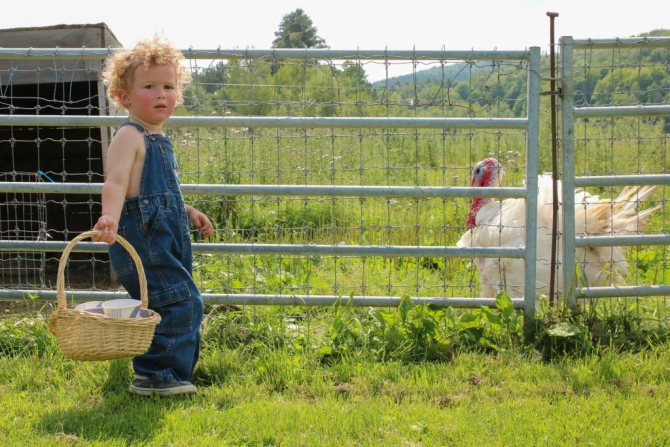

In the summer, turkeys must be given grass and tops of plants. They are high in vitamins and fiber. Nettle, plantain, timothy, clover, alfalfa, lupine, carrot and beet tops, green pea pods are best suited for feeding. Before giving the turkeys the grass, it is thoroughly crushed.
- Corn cobs of milk ripeness - 40%
- Carrots with tops - 40%
- Clover, alfalfa, garden weeds - 20%
All ingredients are crushed and mixed thoroughly. Then loaded into the silo. After 6-8 weeks, the silage can be mixed into feed and wet mash. From wet feed, carrots, boiled potatoes are best suited for turkeys, you can feed the birds with pumpkin, cabbage, beets, but not red. Also give kitchen cleanings, leftovers from the table without spices. If you feed the birds with kitchen scraps, keep them fresh. After all, we ourselves do not eat spoiled foods.
From animal products, meat, meat and bone meal and fish meal are best suited. In summer, on free grazing, the turkey independently searches for itself bugs, worms, midges. She can perfectly fight garden pests.To improve digestion, a bowl of gravel or crushed shells should be placed next to the feeder.
We suggest that you familiarize yourself with: Cattle feeding ration types of feeding
Feeding turkeys at home differs from other members of other poultry. They need a lot of proteins and micronutrients, since inactive behavior leads to obesity. This provokes disease and early death of the bird.
When the mating season begins in males, their appetite disappears.
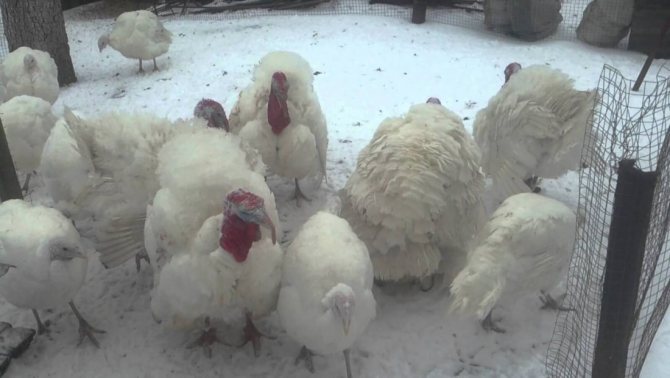

Turkeys in winter
To avoid weight loss, you should:
- Prepare a mixture of fresh vegetables.
- Rub the cheese.
- Giving sprouted grains.
- Include beans and grains.
- Give shivers and foods rich in vitamin B complex. These substances affect the egg production of female representatives.
- Useful products will be carrots, finely chopped, as well as silage. Birds need root crops.
We decided how to feed the turkeys in winter, but in the summer, the solution to the issue is simplified:
- They can be grazed in meadows where many useful plants grow.
- In the summer, it's time to stock up for the winter. It is advisable to make brooms from acacia, birch or poplar. Then hang it around the house so that they can get out without any problems. The branches are placed in a mash, finely chopped.
In addition, phosphorus and calcium should be included in the feed. The nutritional menu includes dry and green nutrients. In winter, you need to include vitamin C, a large amount of it is found in coniferous branches. Poultry fiber is obtained from straw and dry grass. The abundant fat content helps to make the turkey juicy and tasty.
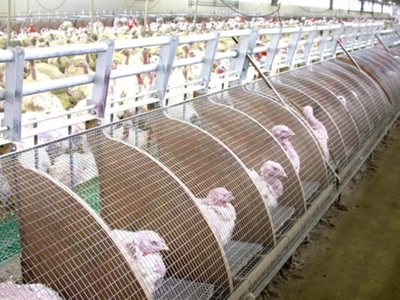

Feeding an adult bird at home is carried out exclusively on a schedule. In the morning and in the evening, dry grain is usually poured into the trough, and twice during this period they give a mash. Wet feed is not stored for future use, as it can sour. It is imperative that the feeders be filled with dry food, and the drinkers should contain fresh water.
Features of feeding adults
Adult feed should consist mostly of grain and compound feed. It is very important to increase the content of animal protein in the diet to 30%.
In the spring and summer
Due to the heat, the feed intake of birds drops. Accordingly, egg production, hatchability of chicks and fertilization of eggs are reduced. Increasing consumption to normal levels can be achieved by increasing complementary foods with green chopped foods and fiber.
In winter
Poultry farmers try to prepare as much hay, silage and brooms as possible for this time. They are the basis for important vitamin and protein-based feeds. Silage harvesting from numerous garden crops is good - carrots with tops, green alfalfa or clover, corn cobs of milk ripeness.
Additional nutrition is provided by a variety of nutty foods. For example, one turkey can eat up to 40 acorns per day, which will provide additional saturated fat and increased carcass weight.
During the laying period
Due to the impoverishment of the bird's body during the laying of eggs, it is necessary to carefully compose the diet of the individual. The amount of vitamins and minerals should be increased. Amino acids are an important component at this time; there should be a sufficient amount of them in the feed. The source of essential amino acids is protein feed.
Also for this period, grain is germinated in hydroponics and introduced into the diet along with proteins of animal origin. Poultry farmers advise giving cottage cheese, yogurt or adding them to a wet mash.
During the tribal period
During this time, the amount of food consumed in males decreases, this is most noticeable in the daytime. To avoid weight loss, increase the proportion of legumes and peas in the diet. Vegetable mixes, finely chopped cheese and sprouted grains are often served in the evening.
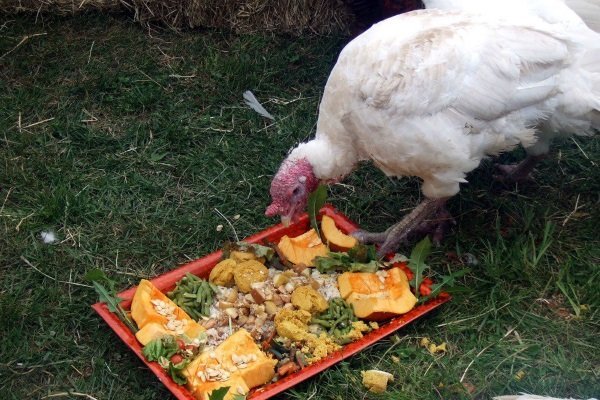

To increase the egg production of females, during the breeding period they are given an increased content of yeast and feed with concentrated vitamin B. Poultry farmers also practice feeding with sprouted grain and root crops.
Fattening for meat before slaughter
To increase the weight of the carcass and achieve the desired level of fatness, forced feeding is practiced. Its purpose is to increase the feed intake of poultry by 25-30%. This will allow you to quickly achieve the desired weight gain by increasing the amount and calorie content of food.
What are the most popular meat breeds of turkeys?
How much does an adult bird weigh? No one will give an unequivocal answer to this question. To obtain a large number of products, you need to choose the right food for turkeys, and also decide on the breed. Most often, their choice is stopped on such popular birds:
- North Caucasian bronze, as they are able to live in any climate. To the question of how many kilograms an adult turkey, grown at home, weighs, you can answer as follows: a male - up to 14 kg, a turkey within 8 kg.
- White broad-breasted. High productivity due to rapid weight gain. These turkeys are light, medium, heavy. An adult male with proper fattening can gain up to 25 kg, a female up to 10. These poultry are able to adapt in any climatic conditions. It is better to plan the slaughter of adults when they reach six months of age: since growth slows down, therefore, the feed will go into the void.
- Bronze broad-breasted. In addition to meat: from a turkey - 17-22 kg, females from 10 to 14 kg, you can get about 120 eggs per year. Grazing is not for them, though. For this breed, you need to prepare aviaries.
- Moscow bronze and white. These powerful turkeys are highly reproductive. With the correct organization of the diet of this breed of turkeys, you can fatten the male up to 13 kilograms, and the female up to 7. The birds are unpretentious, they eat both dry food and a bourgeois woman. The survival rate of turkeys is high.
What should not be fed to turkeys?
- Compound feed for pigs and cattle is prohibited for birds. It is too high in fiber and salt, which can cause loose stools and subsequent death.
- Remember the freshness of wet food. After 20 minutes, the mash becomes unusable. They become sour and can cause poisoning and loose stools.
- Watch out for herbal chopped food. In no case should they include such plants as belladonna, wild rosemary, cicuta and hemlock.
- Don't give the birds too much salt. Its content should not exceed 0.5% of the daily feed weight. Sweets are prohibited at all. Any confectionery product can cause illness and deterioration in the condition of the bird.
By following the above tips and tricks, you will be able to independently formulate the correct diet for turkeys, which will ensure their uniform growth and development, and most importantly, will help maintain their health.
0
When to fatten
Poultry farmers should know not only how to properly feed turkeys, but also the peculiarities of fattening before slaughter. You can cook poultry for meat from 4-5 months, when the weight is at least 8-10 kg. They should receive a complete diet and be kept in proper conditions.
Having outlined a bird for slaughter, you need to start feeding a lot of food at least a month in advance. Most often, mass slaughter is carried out in August-October. Domestic turkeys spend more time on free grazing, saturating the body with vitamins and microelements. When fattening for meat, preference is given to compound feed and flour mash.
How much turkeys should eat during this period per head: usually 800 g of feed, including the mash.
Attention! A well-fed turkey should not be too fat - the quality of the meat is lost.
It is not necessary to use ready-made feed, you can independently prepare a nutritious feed mixture from:
- grains, chopped greens;
- beets, carrots, cabbage leaves;
- cottage cheese, milk;
- flour mixtures:
- fresh waste from fish, meat, eggshells.
When fattening, some breeders forcibly put specially prepared dumplings and dumplings into the bird's beak. Birds can eat them 250 grams. This technique is not so simple, it requires experience. For beginners who are just beginning to learn the basics of growing and feeding, it is better not to use this option.
Important! 3-5 days before slaughter, poultry is restricted in movement, kept in small pens.
In addition to food, they must always have clean water.
We suggest that you familiarize yourself with: Technology of making haylage at home
Before slaughtering a turkey, it is left for 12 hours in a dark room, food is not given, but watered ad libitum.

